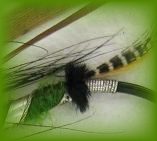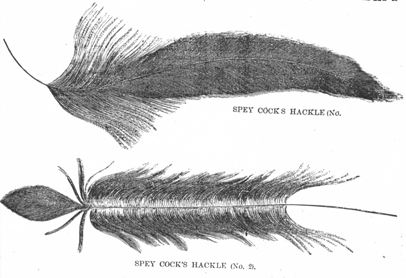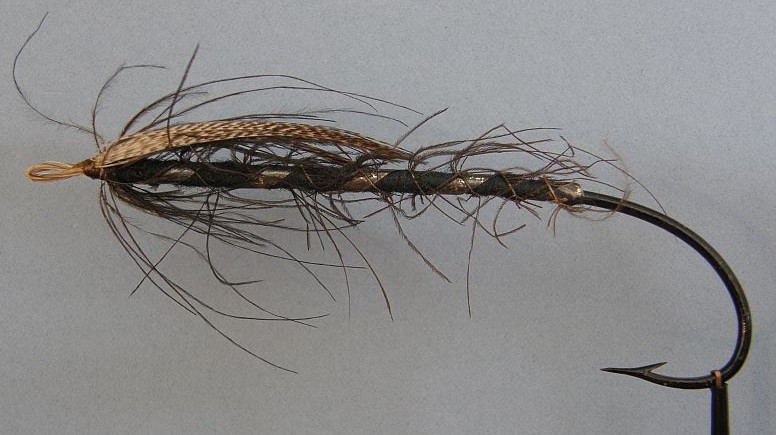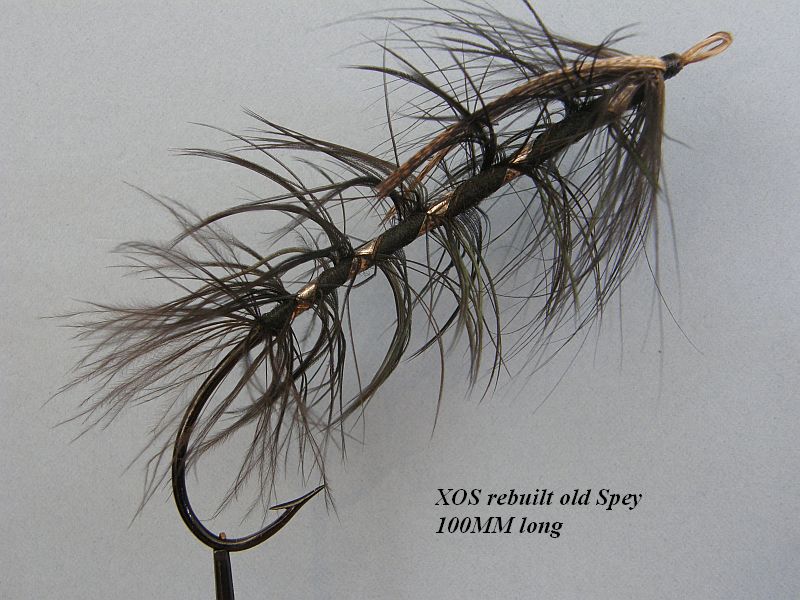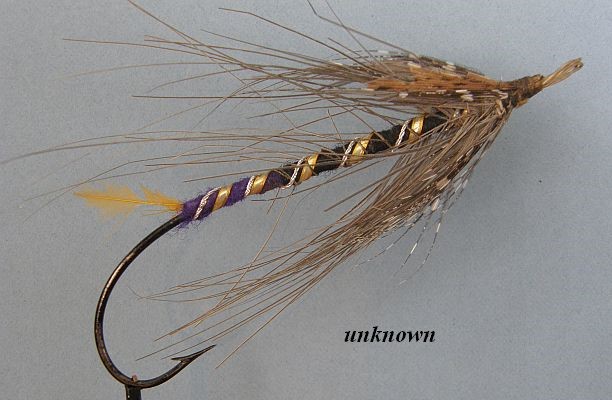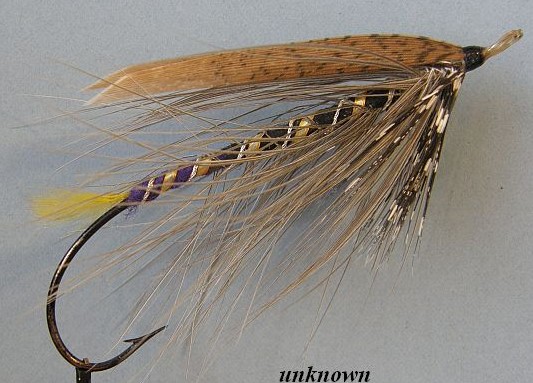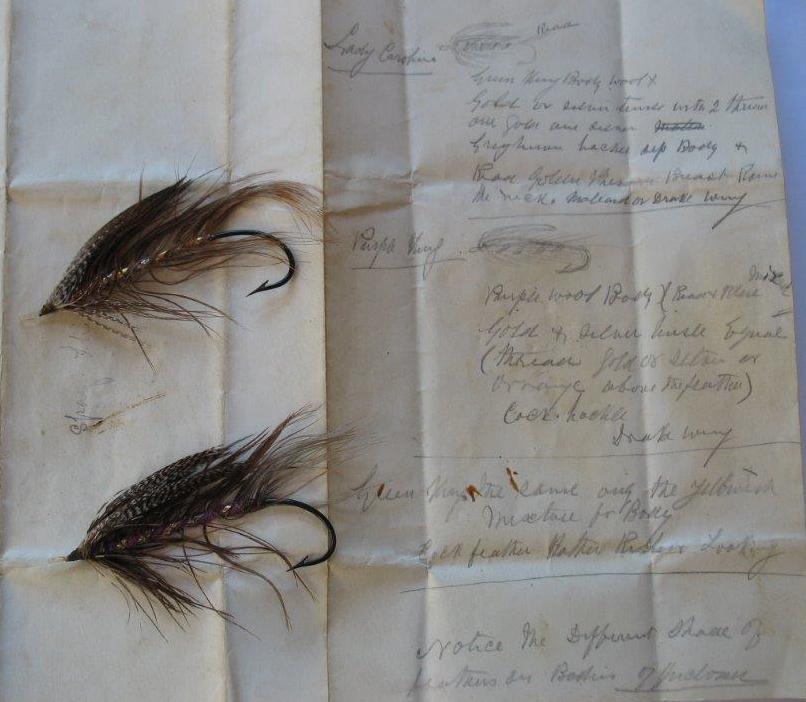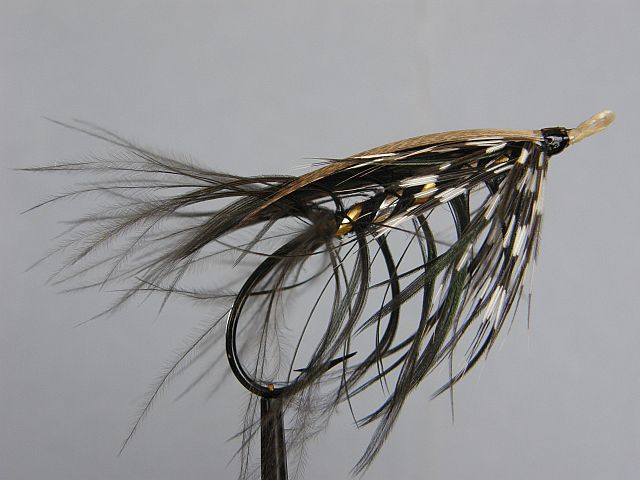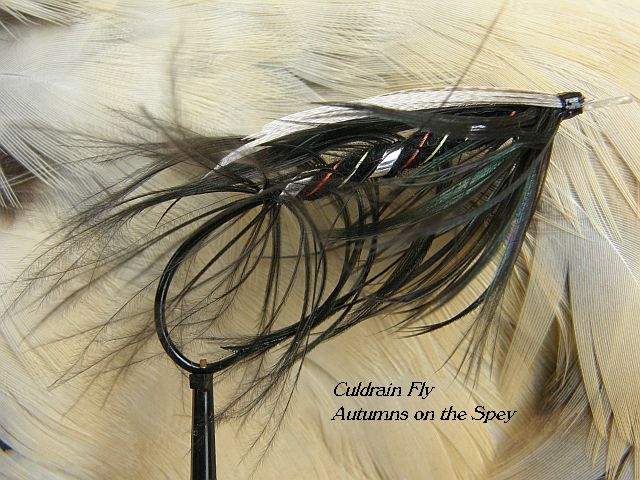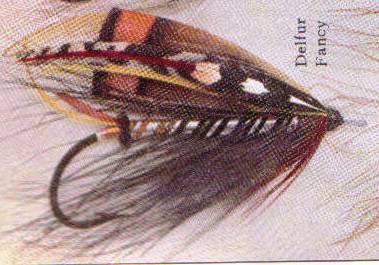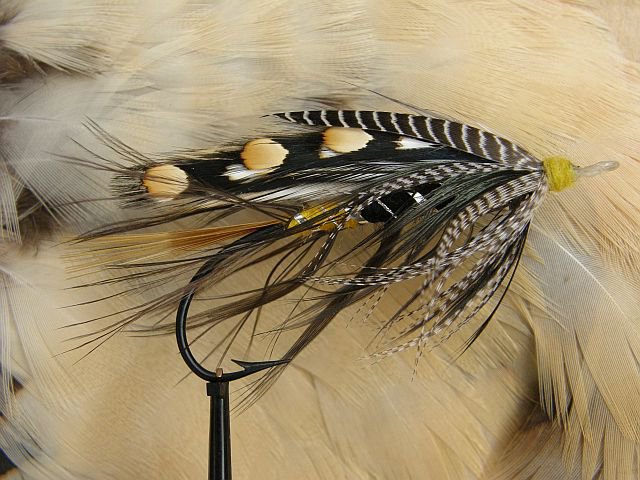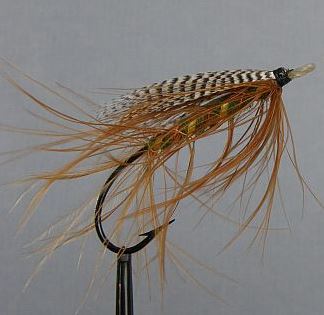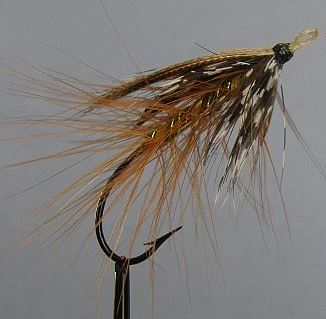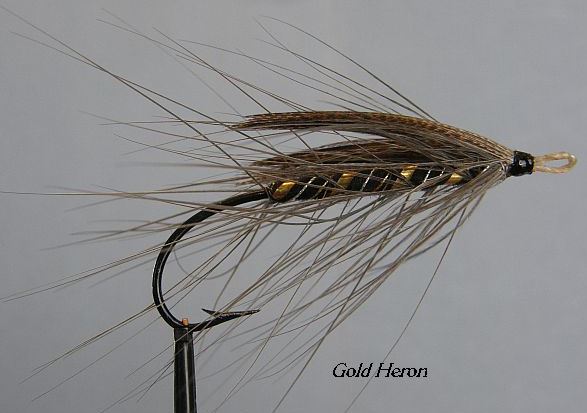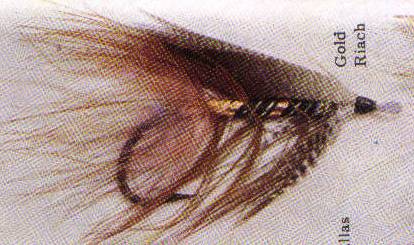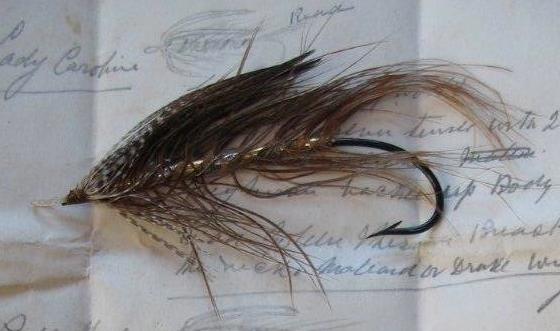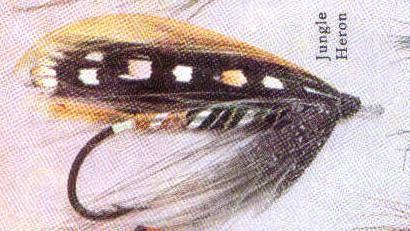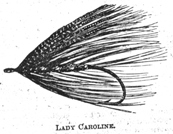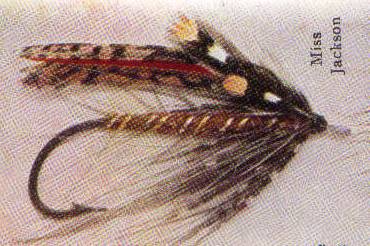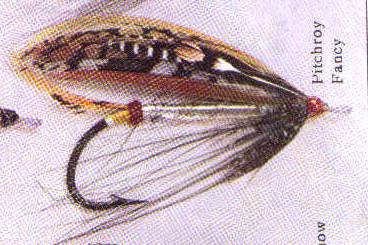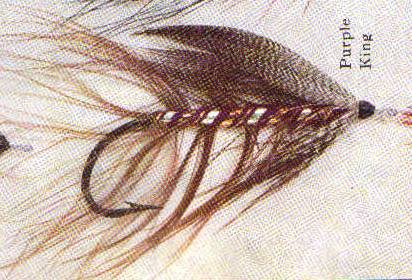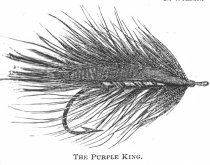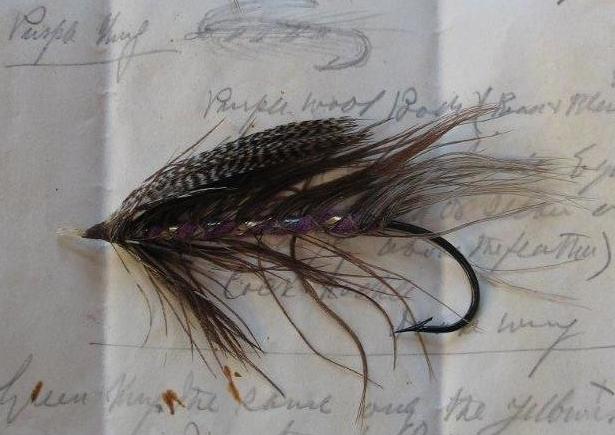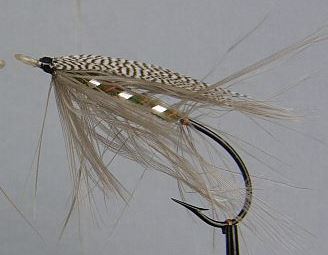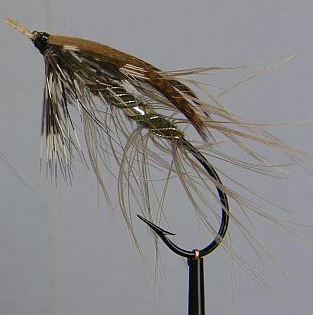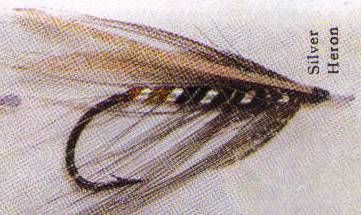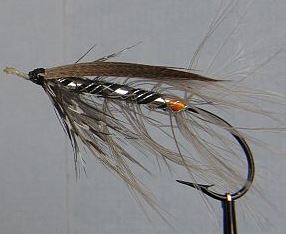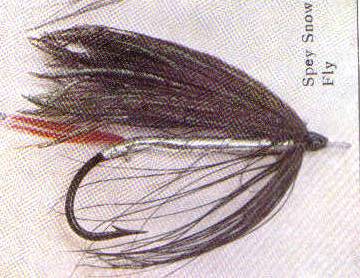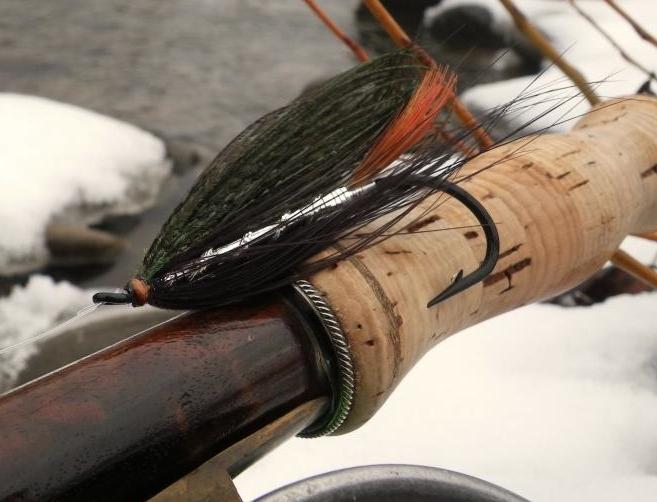 |
 |
|
Spey Flies A Gold Riach from P.D Malloch This page is devoted to the Spey fly - In the hope that is will help us appreciate what a proper Spey fly should look like, most modern ties have the wing too low and short. We start with some wise words on the Spey Fly by Mr Knox - who penned the go-to book for old Spey Patterns "Autumns on the Spey", then to Mr Brown for some instructions on how to tie the Spey fly and what a "Spey hackle" is and finaly we look at some examples of vintage flies and list some pattern details - but please note that I have not researched Spey flies to the same extent as I have the Dee style fly. At the bottom of the page is a great sequence of step by step instructions of how to tie a Spey fly.
Autumns on the Spey - A.E. Knox published 1872
Spey flies, properly so-called, are simple and unassuming both in composition and appearance, yet they are tied with as much skill and care by the best native artists as is exhibited in the fabrication of the most complicated, gaudy lures, formerly imported from Ireland, but now equally well known on the Shannon and the Tweed, and many other Scottish as well as Norwegian rivers. It is true that, of late years, some of these showy strangers have been introduced here, and under certain conditions of sky and water are found more effective than any of the aboriginal type, but, as a general rule, I have found that newly-run fish in the lower waters are more readily captured with flies of the modest native pattern than with the most brilliant exotics that can be produced by a combination of humming-bird, blue and yellow macaw, orange-breasted toucan and the variegated metallic plumage of the golden pheasant.
The term fly" is clearly a misnomer. No insect that ever winged the air bears the slightest resemblance to any of these artificial lures, and even if it did, the motion imparted to the latter under water would be unnatural and impossible. They are evidently taken by the salmon for some of the numerous varieties of Crustacea prawns, shrimps, etc. which, with echinodermata starfish, etc. constitute his rich repast in the depths of the ocean. A conviction of the accuracy of this surmise forced itself upon me a few years ago, while lying down on the bank of a small clear pool, at the tail of a rush of water through one of the lesser arches of Spey bridge, near Fochabers, and attentively watching the motions of a fly at the end of a long line thrown by a young friend of mine an accomplished fisherman from over the parapet above. Its undulating movements under water exactly resembled those of a living shrimp or prawn, while the continuous play of the long soft hackles of the heron or fowl so characteristic of the old Spey flies imitated still more closely the actions of those small, but many-legged crustaceous animals, as I had frequently observed them in the aquarium of the Zoological Society. Notwithstanding the subdued tone and apparent simplicity of all these Spey flies, and a certain family resemblance, if I may use the expression, that pervades them all, yet after a little practice they may be easily distinguished from each other, and however trifling and insignificant these minute differences may appear to the uninitiated, yet in the eyes of the experienced native fisherman they are of considerable importance, and when salmon are shy, success is frequently supposed to depend upon their due appreciation.
It may be hardly necessary to observe, that the component parts of each sort of fly are unaffected by its size. This varies considerably. Those which are in vogue during the spring months in the upper waters, when the river is exceedingly high and rapid and the pools unusually deep, being really enormous compared with their minute representatives which are generally found most successful in the summer months and early autumn, but much must be left to the judgment of the fisherman himself; there is no role without an exception, and I have frequently found it necessary, after a moderate rise of the water, to employ flies twice as large as those which I had found of faultless dimensions but a few days before. The following is a list of old Spey flies. To every fisherman on the river it will be sufficient to say that the descriptions are taken from specimens tied by that accomplished artist, Shanks, of Craigellachie, of whom Mr. Barney Maguire, if he had ever visited the Spey, might perhaps have sung : There's Mister Shanks too, upon the banks too, Och thats the fellow that can throw a loine, A clever boy too, he can tie a floy too, For art and practice he does both comboine.
Several varieties have of late years been added, which, though modest and unassuming compared with the gaudy exotics to which I have already alluded, must still be considered innovations, partaking as they do, more or less, of the plumage of the golden pheasant; they are consequently omitted from the [above] list, which professes to be nothing but a brief descriptive catalogue of old Spey flies. N.B. The dubbing or bodies of all these flies is composed of Berlin wool.
I must content myself this week with giving illustrations for two favourites, the Lady Caroline and the Carron, and some most useful remarks on the dressing of Spey flies generally, kindly sent to me by Mr. Brown, of George Street, Aberdeen, who makes these and all other standard salmon flies to perfection. Mr. Brown says:-
To describe the dressing of a Spey fly generally, and not any pattern in particular, I think the clearest plan would be to follow the tabulated form used in the Badminton volume on Fishing, when describing the ordinary standard flies, which would show these particular constructions differ in their in their respective parts from the well known standards. Thus, an ordinary fancy fly, with say a wool or fur body, would have all the parts which are indicated in italics, where as the Spey fly takes only those that are described, viz:-
Tag. None. Tail. None. Butt. None. Body. Usually consists of common wool mixed or dyed to the shade of colour required, and wrapped round the body tightly. There is no picking out or furriness about the body of a Spey fly; and it is begun on the shank in a line with the point of the hook, it has a dumpy disproportionate appearance. Ribbed. There are invariably three tinsels down the body a flat, and two threads; one of the threads silver, the other gold (on some patterns these are replaced by coloured silk threads). The flat and one thread is wound round the body in three turns, room being left for the second thread, which is not wound until after the hackle is put on. Hackle. The hackle is perhaps the most distinguishing feature of the Spey fly, and the greatest puzzle both to amateur and professional fly-tiers. It is not, properly speaking a hackle, but it is taken off that part of the cock which might be called the saddle, or near the tail. The best feathers hang with a graceful curve from the root of the tail down the side of it, and when the fibres are extended to right angles with the stem, they will be found to be of equal length butt to tip, not tapering as in a hackle. The feather thus described is very soft in fibre, and when dressed on the fly, has a very different appearance to the ordinary cocks hackle, and a very different effect in the water.
Spey Cock Hackle
Now as the hackle of the Spey fly differs from ordinary hackles, so does the manner of putting it on. The ordinary standard fly has the hackle tied in, or begun, at the small tip or point. The Spey fly has it tied in, or begun, at the butt or thick end of the stem. Having cleaned off the downiest part of the fibre at the butt-end, and left just a little of the gray (as sort of half down, half fibre), and having seen that the fibre is long enough to extend about half an inch beyond the bend of the hook the stem is tied in at the very commencement of the body, along with the tinsels. When the two tinsels a flat and a thread have been wound to the right hand, the hackle is taken and wound to the left hand. The tinsel is then wound to the right, parallel with the other two, and across the hackle stem at every turn. When fixed, a needle is required to relieve those fibres of the hackle which may have been tied down by the crossing tinsel. The fly is ready for the Throat Hackle, which is generally teal, wound in the ordinary fashion. Wings are generally two double strips of brown mallard, not extending much above the length of the body, and set to permit the natural curve of the feather. The two wings are set quite apart, and are put on separately. Sides. None. Horns. None. Head. Black silk.
Writing in the 1890s - a keen Spey Fisher : So what does a really old Spey Fly look like?
The before - wing has not been damaged but the hackle is very broken or "mothed"
The after - body, ribbing and wing retained, new hackle and head Another "hospital case" that received treatment from Bob Frandsen - same size and from the same wallet as above (these were all Spey Flies)
Note that in this case the wing material is Turkey and the body hackle is Heron
Restored ! Ian Letham sent me some pictures of a couple of nice spey flies that came in a fold of paper with some pattern details and dressing hints, I have put slightly larger photos of the individual flies in the Pattern section, here is a photo of both with the text, and then the text typed out:
The text from the wrapper: Lady Caroline Green King body wool*. Gold and silver tinsel with 2 threads. One gold, one silver. Grey heron hackle up body and head, golden pheasant breast around the neck. Mallard or Drake Wing. Purple King Purple wool body (red and blue mixed), gold and silver tinsel equal (thread gold and silver and arrange above the feather). Cock Hackle. Drake Wing. Green King
The same only the yellowish* mixture for body. Cock feather rather richer looking. Notice the different shade of feathers on bodies of enclosed.
Black Heron
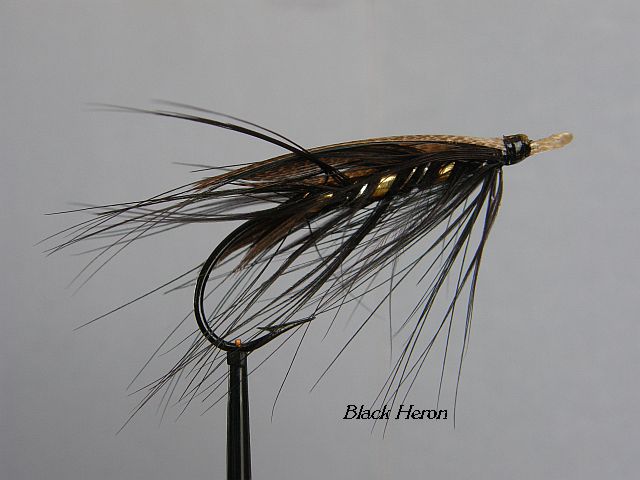 Tied by Bob Frandsen
Knox - Autumns on the Spey
Black Heron. Same as the Gold Heron, but instead of the slate-coloured back hackles of the heron, use the tips of the black feathers from the breast of that bird. Black King The flies known as "kings" are characterized by having altenative bars of gold and silver tinsel. No beading of any kind
Carron A vintage fly from JAJ Munro of Aberlour-on-Spey c1910-1920 (part of a set of sample flies) 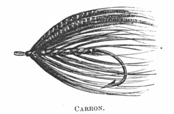 From the fishing Gazette (William Brown) Browns Spey flies, 24th Jan 1891, R.B. Marston, Fishing Gazette
Body: Orange wool; about three or four turns of flat silver tinsel. Hackle: Black heron, wound round the whole length of the body. Wing: Mallard; long and flat.
In spring and autumn, when the fly is used of larger size, the body is often made of a greenish yellow wool, instead of the orange; and two or three turns of gallina hackle are added at the shoulder.
Carron Fly. Body orange, bars of silver tinsel. Hackle, black feather from the breast of the heron. Wing, mallard.
Knox - Autumns on the Spey
Delfur Fancy
Gold-green fly
Knox - Autumns on the Spey
Knox - Autumns on the Spey
Knox - Autumns on the Spey Gold Purple Fly, commonly called "Gold Purpy." Body purple. Red cock hackle, with bars of gold tinsel. Wing, mallard.
Knox - Autumns on the Spey fine along the body of the fly. Shoulder hackle of teal or guinea-fowl. Wing, mallard.
Knox - Autumns on the Spey Gold Speal. Is generally on a large hook. Body black, with only two or three turns of very broad gold flat tinsel and with a single turn of fine silver beading between the bars of the tinsel. Red cock hackle, very soft,taken from the tail coverts of the bird. Wing, mallard.
Green King
Another vintage Green King this one from Ian Letham's collection
Knox - Autumns on the Spey
The flies known as "Kings" are characterized by having alternate bars of gold and silver tinsel. No beading of any kind.
Jungle Heron
Lady Caroline
The 3 flies above are part of Paul Harkin's collection and show interesting variations of the Lady C
Browns Spey flies, 24th Jan 1891, R.B. Marston, Fishing Gazette
Tail: Red feathers from golden pheasant. Body: Reddish brown wool with flat silver tinsel, and two threads between, one gold and one silver. Hackle: Long grey heron, wrapped round the whole length of the body. Shoulder: Two or three turns of the red hackle of the golden pheasant.
The Purple King
A vintage Purple King from Ian Letham's collection
Browns Spey flies, 24th Jan 1891, R.B. Marston, Fishing Gazette
This very favourite Spey pattern is made as follows:-
Body. Light purple wool, ribbed with one flat and two thread tinsels; one gold and one silver Hackle. Brownish black feather from side of cocks tail, would contrary to tinsels and crossed by one of them. Teal at shoulder Wing. Double strips of Mallard, short and set apart to allow hackle to appear between them.
Knox - Autumns on the Spey Purple King. Body lake colour, composed of scarlet and purple mixed. Alternate bars of gold and silver. Hackle, grey or red cock, according to fancy. Shoulder hackle, teal. Wing, mallard.
The flies known as "Kings" are characterized by having alternate bars of gold and silver tinsel. No beading of any kind.
Red King
Knox - Autumns on the Spey Silver-Green Fly. Same as above, but with silver tinsel and grey cock hackle.
Silver-Green Reeach
Silver-Green Reeach. Same as Gold-Green Reeach, but with silver tinsel and beading instead of gold.
Silver Heron
From Gardens 1917 catalogue
Silver Reeach
Knox - Autumns on the Spey
Silver Speal. Same as Gold Speal, but the flat tinsel is of silver and the beading between the bars of gold.
From Gardens 1917 catalogue
And here is a tied in hand Spey Snow fly ready for action - by Adrian Cortes (Note that Adrian uses dyed Blue Eared Pheasant as a sub for a black Heron hackle - works well!) Step by Step tying a Spey fly in hand by Matt Arciaga 1. Select gut in a size to match shank of hook, bind in with heavy wax and wraps of thread touching not overlapping, tie in gut to 9/10 body length. (body will be to point of hook) 2. Select and bind from the bottom a natural red coque tail side hackles. To make up some of the elevation change from gut to shank secure on the bottom of the shank. 3. Bind in a gold flat tinsel and gold oval and silver oval lace. Flat should be secured in at approx. (6) o clock, the gold oval secured in at approx. (9) o clock and the silver oval secured at approx. (3) o clock. Hook diameter is looked at from spear to back and compared to clock. 4. Secure 2 strand of orange berlin wool at (6) o clock. Now you will have a bundle of materials ready to move forward. Note that most of the elevation change from gut to shank on the underside is now filled with, stem, tinsel and wool. 5. View from side of bundle (sorry about the photo, seems to have compressed!) 6. Take the orange berlin wool forward to approx. ¼ the body length, secure tag end and scissor. 7. Bind in 2 strands of black berlin wool 8. Take Black berlin wool forward to approx. 7-9 mm from the spear end, secure tag end and scissor 9. Take the flat tinsel first with 4 turns turned clockwise, secure; take the gold lace forward keeping equal spacing with flat as the basis of angle on the tinsel pitch. 10. Wrap hackle forward in counter clockwise overlapping the flat tinsel and oval lace. 11. Move the silver oval lace forward clock wise, where hackle stem and tinsel intersect use bodkin to separate fibers along the hackle stem and advance the lace forward over the hackle stem, all while ensuring the pitch is matching the other tinsels and that the silver lace wrap does not become a weak wrap. Secure tag end, scissor. Secure teal throat hackle and take at least 1.5 turns, 2.5 max depending on density of fibers. Note how neither of the hackles were stripped on a side. 12. Take two identical slips (1 from each side) of a turkey tail or upper major tail covert. Place them back to back as you would an underwing on a classic salmon fly. Compress fibers without collapsing the slips as shown, slips can be set a touch longer than the body but no longer than the bend of the hook 13. Place the bronze mallard and place alongside the back to back turkey slips, after compressed you can adjust to set true and even. 14. Create small tapered head
|
